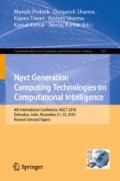Abstract
In this paper, we propose a network framework for dynamic IoT applications such as smart healthcare system, animal monitoring system, which supports the core IoT feature: scalability. The proposed framework uses hierarchical topology for node deployment. To support uniform energy consumptions, the network is divided into equal size zone so that network load can be distributed equally and network lifetime can be increased. To make this framework more realistic as animal monitoring and smart healthcare system, Random Waypoint Model is used for node mobility under scheme 1 and scheme 2. In scheme 1, nodes can move in entire network and in scheme 2 nodes can move in their respective zones only. To avoid long distance communication, some nodes are promoted as relay node, zone head and zone coordinator. Sensor nodes begin the communication via nearest relay node. Relay node forward the packets to the zone head and zone head transmits these packets to base stations via upper layer zone coordinator. In the RN selection, we consider the ratio of node to zone head (ZH) distance and their residual energy. The node with shortest ratio is selected as RN. The comparison has been made of the proposed framework with static model, mobile under scheme 1 and 2.
Access this chapter
Tax calculation will be finalised at checkout
Purchases are for personal use only
References
Lee, I., Lee, K.: The Internet of Things (IoT): applications, investments, and challenges for enterprises. Bus. Horiz. 58(4), 431–440 (2015)
Aijaz, A., Aghvami, A.H.: Cognitive machine-to-machine communications for Internet-of-Things: a protocol stack perspective. IEEE Internet Things J. 2(2), 103–112 (2015)
Al-Fuqaha, A., Guizani, M., Mohammadi, M., Aledhari, M., Ayyash, M.: Internet of things: a survey on enabling technologies, protocols, and applications. IEEE Commun. Surv. Tutor. 17(4), 2347–2376 (2015)
Kumar, J.S., Zaveri, M.A.: Hierarchical clustering for dynamic and heterogeneous internet of things. Proc. Comput. Sci. 93, 276–282 (2016)
Younis, M., Youssef, M., Arisha, K.: Energy-aware management for cluster-based sensor networks. Comput. Netw. 43(5), 649–668 (2003)
Liu, J.S., Lin, C.H.R.: Energy-efficiency clustering protocol in wireless sensor networks. Ad Hoc Netw. 3(3), 371–388 (2005)
Heinzelman, W.R., Chandrakasan, A., Balakrishnan, H.: Energy-efficient communication protocol for wireless microsensor networks. In: Proceedings of the 33rd Annual Hawaii International Conference on System Sciences, pp. 10-pp. IEEE (2000)
Priyan, M.K., Devi, G.U.: Energy efficient node selection algorithm based on node performance index and random waypoint mobility model in internet of vehicles. Cluster Comput. 21, 1–15 (2017)
Mhatre, V., Rosenberg, C.: Homogeneous vs heterogeneous clustered sensor networks: a comparative study. In: ICC, pp. 3646–3651 (2004)
Heinzelman, W.B., Chandrakasan, A.P., Balakrishnan, H.: An application-specific protocol architecture for wireless microsensor networks. IEEE Trans. Wirel. Commun. 1(4), 660–670 (2002)
Loscri, V., Morabito, G., Marano, S.: A two-levels hierarchy for low-energy adaptive clustering hierarchy (TL-LEACH). In: 2005 IEEE 62nd Vehicular Technology Conference. VTC-2005-Fall, vol. 3, pp. 1809–1813. IEEE (2005)
Younis, O., Fahmy, S.: HEED: a hybrid, energy-efficient, distributed clustering approach for ad hoc sensor networks. IEEE Trans. Mob. Comput. 3(4), 366–379 (2004)
Othman, M.F., Shazali, K.: Wireless sensor network applications: a study in environment monitoring system. Proc. Eng. 41, 1204–1210 (2012)
Huang, J., Meng, Y., Gong, X., Liu, Y., Duan, Q.: A novel deployment scheme for green internet of things. IEEE Internet Things J. 1(2), 196–205 (2014)
Rani, S., Talwar, R., Malhotra, J., Ahmed, S.H., Sarkar, M., Song, H.: A novel scheme for an energy efficient Internet of Things based on wireless sensor networks. Sensors 15(11), 28603–28626 (2015)
Shah, T., Javaid, N., Qureshi, T.N.: Energy efficient sleep awake aware (EESAA) intelligent sensor network routing protocol. In: 2012 15th International Multitopic Conference (INMIC), pp. 317–322. IEEE (2012)
Niculescu, D., Nath, B.: Localized positioning in ad hoc networks. Ad Hoc Netw. 1(2–3), 247–259 (2003)
Shen, J., Wang, A., Wang, C., Hung, P.C., Lai, C.F.: An efficient centroid-based routing protocol for energy management in WSN-assisted IoT. IEEE Access 5, 18469–18479 (2017)
Han, Z., Wu, J., Zhang, J., Liu, L., Tian, K.: A general self-organized tree-based energy-balance routing protocol for wireless sensor network. IEEE Trans. Nucl. Sci. 61(2), 732–740 (2014)
Chang, J.H., Tassiulas, L.: Energy conserving routing in wireless ad-hoc networks. In: Proceedings IEEE INFOCOM 2000. Conference on Computer Communications. Nineteenth Annual Joint Conference of the IEEE Computer and Communications Societies, pp. 22–31. IEEE (2000)
Shukla, A., Tripathi, S.: An optimal relay node selection technique to support green internet of things. J. Intell. Fuzzy Syst. 35(1), 1–14
Oliveira, L.M., Rodrigues, J.J.: Wireless sensor networks: a survey on environmental monitoring. JCM 6(2), 143–151 (2011)
Author information
Authors and Affiliations
Corresponding author
Editor information
Editors and Affiliations
Rights and permissions
Copyright information
© 2019 Springer Nature Singapore Pte Ltd.
About this paper
Cite this paper
Shukla, A., Tripathi, S. (2019). Analysis of Energy Efficient Framework for Static and Mobile Nodes in WSN-Assisted IoT. In: Prateek, M., Sharma, D., Tiwari, R., Sharma, R., Kumar, K., Kumar, N. (eds) Next Generation Computing Technologies on Computational Intelligence. NGCT 2018. Communications in Computer and Information Science, vol 922. Springer, Singapore. https://doi.org/10.1007/978-981-15-1718-1_23
Download citation
DOI: https://doi.org/10.1007/978-981-15-1718-1_23
Published:
Publisher Name: Springer, Singapore
Print ISBN: 978-981-15-1717-4
Online ISBN: 978-981-15-1718-1
eBook Packages: Computer ScienceComputer Science (R0)

